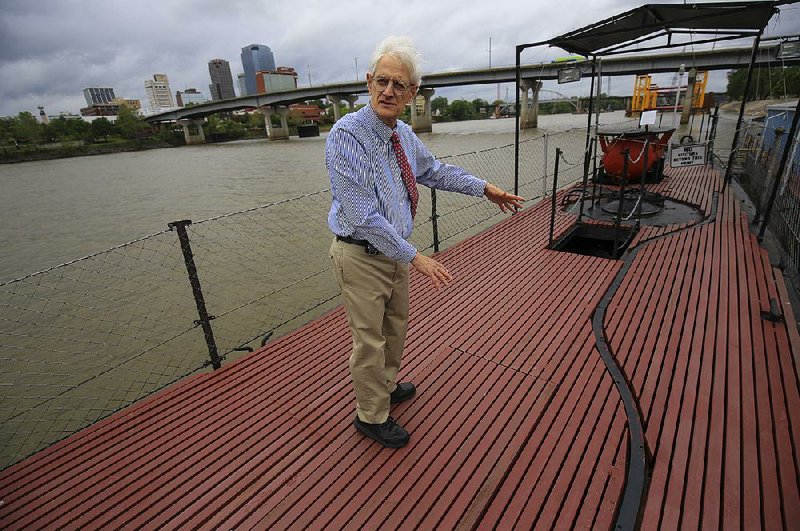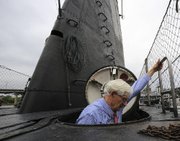Charlie Duveen's eighth-grade physics class in New York is designing a nuclear-powered submarine as a semester project due in time for review Thursday by U.S. Navy architects and engineers.
But Duveen's attention Tuesday was on a different submarine: The USS Razorback in North Little Rock, the World War II sub that rescued his father, Charles Duveen, and three fellow crewmen from ocean waters after their aircraft had been downed by Japanese fighter planes June 5, 1945.
"I wasn't born until a year later," Duveen said after going through the sub that is featured at the Arkansas Inland Maritime Museum on the Arkansas River in North Little Rock's downtown. "I wouldn't be here if this ship had not picked him up."
Duveen and his wife, Aggy, visited the North Little Rock area Monday and Tuesday at the invitation of former U.S. Rep. Vic Snyder of Little Rock, a Maritime Museum board member. The museum had a donor reception Tuesday evening and asked Duveen to attend as its guest.
As the teacher of a class with its major project due the same week, Duveen certainly had a conflict. His students understand his decision, he said. And the Duveens will head back today, so he'll be in class Thursday for the presentation.
"I tell them about my dad, and they know all about this submarine," Duveen said of his students. "I've been talking about it for years, but I haven't visited it. I never would have put my students off for three days before this. I thought I'd let them fend for themselves for once.
"I'd certainly love to help," he said of meeting with museum donors.
Greg Zonner, the museum's executive director, said he and others have researched events known to be associated with the Razorback, which was active during World War II, the Vietnam War and the Cold War. The research included finding the names of airmen the submarine rescued, as recorded in its log books and historical accounts.
"We gave [Snyder] what we had, and he made some cold calls," Zonner said. "He did all the legwork."
Duveen's father died in 2001, but Snyder said Tuesday that he found a number for an upstate New York bed-and-breakfast run by a Charles Duveen, the son of the downed airman. Only one of the four crew members who were plucked from the ocean's shark-infested waters, Arthur Lieberi, is alive, he said.
"I knew about the submarine [history] from Lieberi," Duveen said. "He sent me a picture of it he had gotten from his son. I had no idea this ship was still around until I got a call from Vic Snyder."
His trip to Arkansas, his first, Duveen said, was important "just to actually see the ship and to be on it."
Charles Duveen, a lieutenant, was the bombardier on the B-29 Superfortress called Mascot 31, part of the 498th Bombardment Group that had made a nine-plane bombing run over Kobe, Japan. Six Japanese fighters made a coordinated attack on the bombers just off the coast. Their plane's No. 1 engine was knocked out, and its tail gunner severely wounded, so the plane wasn't returning fire.
A Japanese fighter plane, apparently out of ammunition, rammed the tail of the bomber, according to the book Point of No Return: The Story of the 20th Air Force by Wilbur H. Morrison. At 10,000 feet, the U.S. crew was ordered to bail out. Duveen, Staff Sgt. Lieberi, Lt. John Kesekes and Lt. John Duffy parachuted from the plane and were rescued from rafts within sight of the Japanese shoreline. The other crew members were lost.
"They landed about 3 miles off the coast of Japan," Duveen said, citing a historical account of the rescue. "It was the closest rescue to Japan's coastline that any ship made."
Lt. Duveen dropped out from the bombing chute, the younger Duveen said. A Japanese plane made several passes of Duveen's parachute, according to Morrison's book, but "mysteriously did not use ammunition."
Other Japanese planes dropped depth charges at the rafts. The men were in the water for about two hours, Charlie Duveen said.
"There were sharks all around in the water," he said. "If they were picked up by a Japanese ship, they would go to a prisoner-of-war camp. If they had landed on land, they would have been beaten up by the people there, because they had just dropped their bombs on them."
The Razorback, on "lifeguard duty," spotted a one-man life raft, Lt. Duveen's, at 11:27 a.m. June 5, 1945, according to the boat's log, which the museum possesses. He was first to be picked up at 11:38 a.m. The other three, with their rafts tied together about a quarter of a mile from Duveen, were rescued seven minutes later. That evening, the four were transferred to the submarine USS Dragonet so the Razorback could continue its mission.
Walking through the Razorback submarine Tuesday, Charlie Duveen said he began thinking about which hatch his father had gone through and where he had been on the sub.
"Probably the first thing they did was go to the galley to get some food," Duveen said. "I went into the galley and sat down. I might have been sitting in a seat my dad sat in on June 5, 1945. Being able to be sitting in there, it was kind of amazing."
Metro on 04/20/2016

